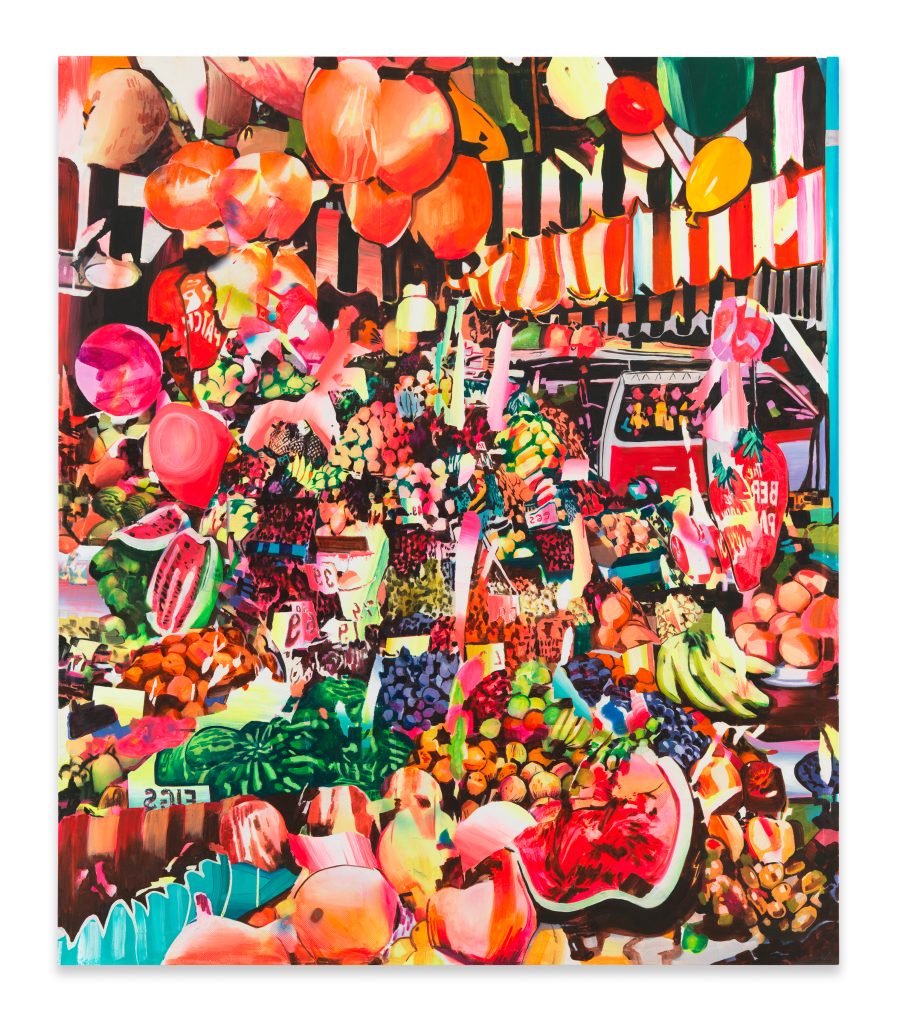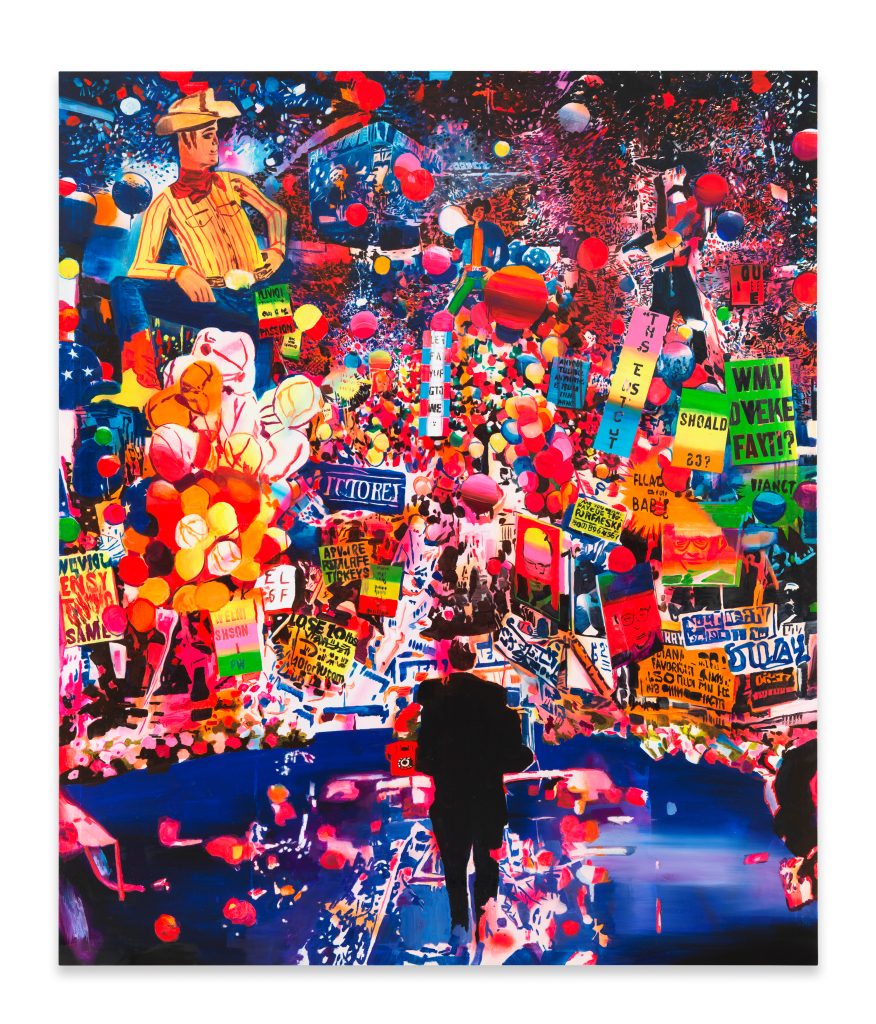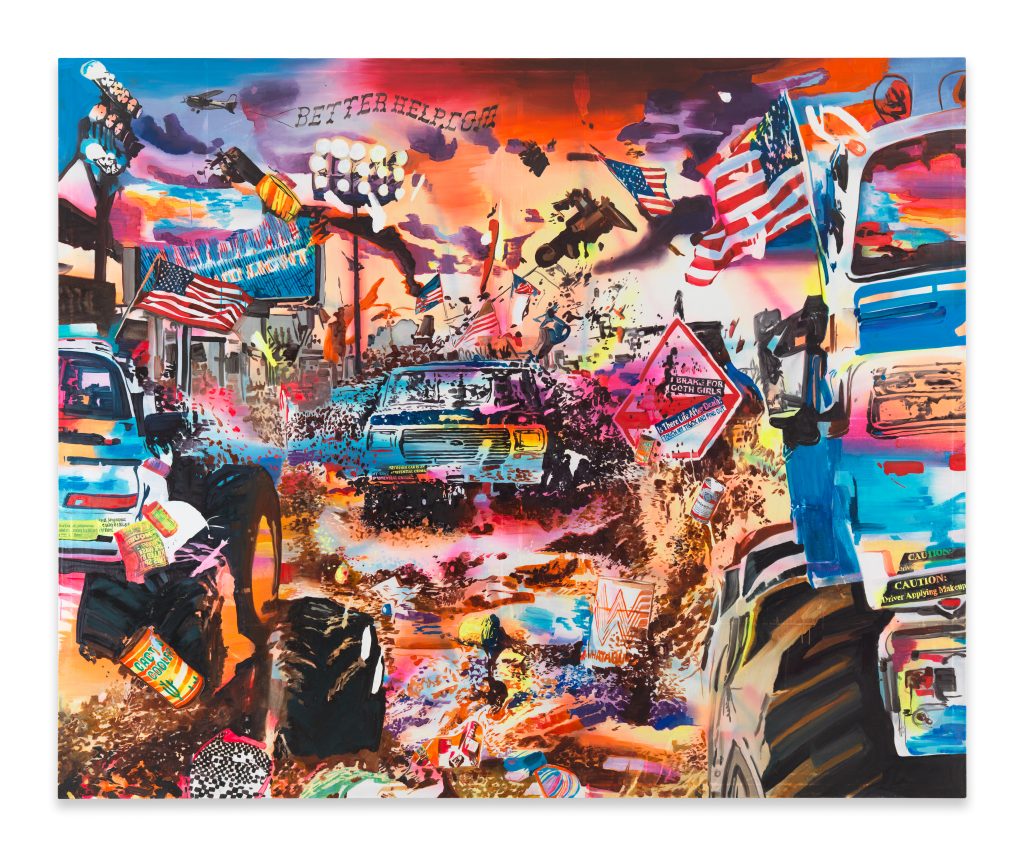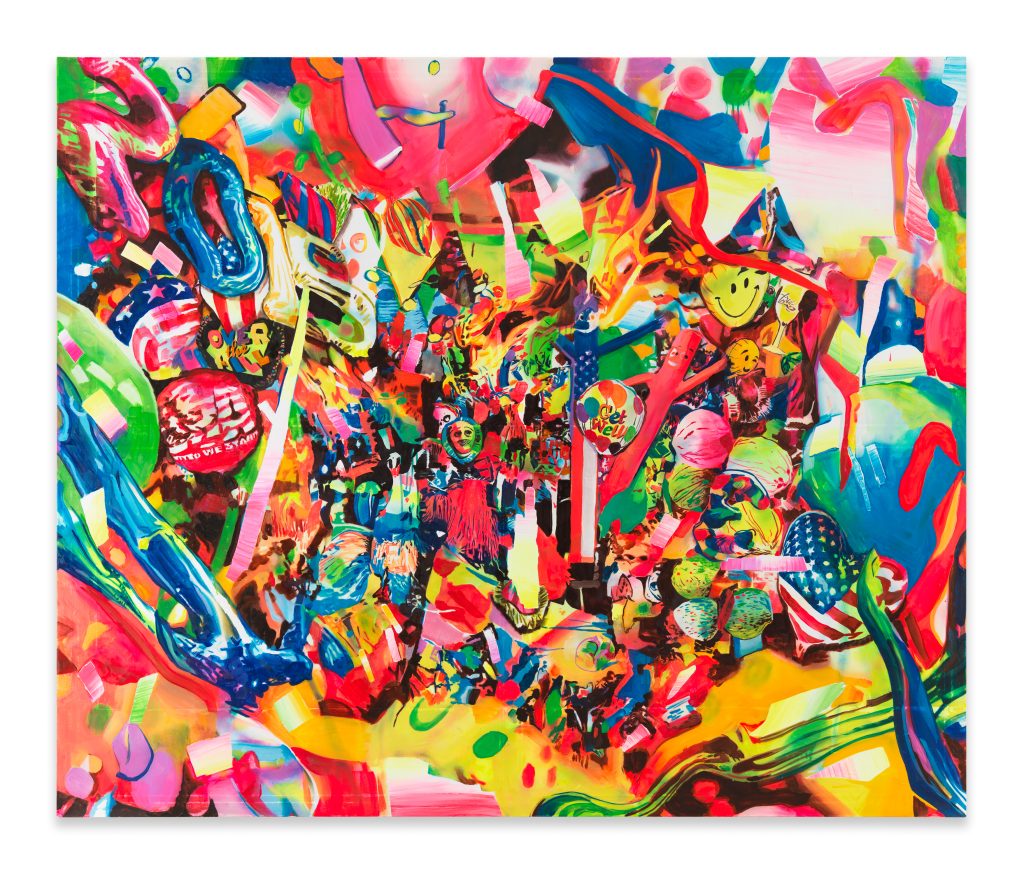The relatively large paintings from Los Angeles-based artist Rosson Crow that are part of the new solo exhibition “Babel” at Miles McEnery Gallery in New York City are vibrant, entrancing, unsettling, hilarious, gripping, and terrifying.
Stormy Fireworks of Color
The works tend to be ultra-saturated and are apparently all comprised of acrylic, spray paint, photo transfer, and oil on canvas. Each suggests a real, physical scene, using imagery — sometimes all-too-familiar — that hearkens to the real world but laying forms atop each other in a manner that wouldn’t quite work in actual space and is clearly suggestive of mental overwhelm.
Think of visually capturing the absolute tidal wave of product that confronts each visitor somewhere like Walmart or Amazon.com. Sometimes, like with “Market Volatility” (2023), that parallel is extremely direct. The work depicts an apparent fruit market in which the edible wares are stacked atop each other outwards into suggested space in that manner which breaks (by a lot) the confines of strict representation.
It screams at the viewer, one might say — a streaking volley of overload. And it’s not just about the familiar and explored undercurrent of a push to buy, buy, and buy again. It also touches on an overarching weight of everything enveloping itself: a scene becoming consuming. A visual ouroboros.
A key facet to this selection of works is also the particularities of the color palettes. Save rare exceptions, like “Looted” (2024), Crow’s works center extremely heated tones, with everything presented at such a fever pitch that the scenes somehow sweat, as though feverish. And color bleeds, at times — in a manner breaking with the expectation to represent anything physically precise at all. It veers into tangible abstraction in some of the nooks of this exhibition.

Monster Trucks, Online Therapy, and Elections
Crow’s references get very specific. I found “Monster Jam Sponsored By BetterHelp.com” (2024) the funniest. It’s pretty much exactly as described — several large trucks roaring through the scene, with visual comprehension fraying as if the trucks are powerful enough to break their reality’s visual bounds. BetterHelp is a therapy company whose advertisements are infamous across the internet, partly for their persistence.
There’s a through-line in some of the paintings that utilizes, as the exhibition’s title references, the Biblical story of the tower of Babel, which involves a tower meant originally to reach the heavens before God — as the story goes — created different languages among those trying to put up the thing, essentially forcing them to separate. The undercurrent, at least as I always encountered it, is a warning about pride. Crow’s works link the story with developments in the socio-political arena.
Working through the tale, Crow’s exhibition eventually gets to “Confusion of Tongues” (2024), which was mesmerizing in scope — like the rest of Crow’s work — but gut-wrenching.
Our vantage point as the viewer is behind a presumed politician looking out at incomprehensibly massive crowds, with signage and balloons dotting the scene as though it’s a party convention. But none of the signage is comprehensible.
As the scene stretches out and away from you, you’re left with the distinct impression that whatever the source of the communal disconnect that it captures, the fracture already formed and can’t be so easily undone. The size of the piece, which is seven feet tall, amplifies this.
Obviously, that connects to a lot of people’s experiences of current politics, though I can only speak most directly to the U.S. environment, although I see the news from elsewhere, too. But, in freshly sharp relief, many of the divides experienced across U.S. society have seemed to become moral and, perhaps, impassable, at least in some’s imagining.
There are obvious, recognizable touchstones in Crow’s work. Many of us have seen a political event, which for us in the U.S. very often doubles as an explicitly election-focused one. And the tone with which the forms build atop each other is monumental to the point of aesthetic symphony or opera: presence atop presence, etc. But it’s clearly breaking down, and with the scenes so sweeping, those cracks spreading across the surface of what you’re seeing are themselves monumentally impactful. It’s a shattering break that’s clearly outside any individual’s control.
The scene is left uneasy: a slowly rotted ship where the structure is now disassembling, destruction getting away from you.

The Weird Future is Here
No matter that expansive aesthetic vista, it’s not all just morbid. There’s a clear opportunity here to not ignore the real-world impacts of what Crow is referencing from our collective experience but still appreciate the roller-coaster. The threads of American culture that Crow’s paintings bring to our attention are sometimes gloriously absurd. “My other car is an existential crisis,” says a bumper sticker in the painting with those hulking, beastly monster trucks. Sure, dude; maybe it is.
The explosive mode of being on display across this exhibition obviously isn’t strictly American, but wherever you find it, the impacts seem likely to be similar, where you’re easily left wondering what the hell you’re even looking at.
Crow’s paintings are thereby timely, true-t0-life, and exciting. There’s a lot of potential inherent to a time in history as ridiculous as this one, and optimistically, Crow’s works get there.
“Babel,” featuring 12 new paintings by Rosson Crow, will continue at Miles McEnery Gallery through July 3.


Featured image: “Monster Jam Sponsored By BetterHelp.com,” same credits as above
You may also like
-
Diana Kurz at Lincoln Glenn in New York: A Review of a Shining Art Exhibition
-
Dustin Hodges at 15 Orient in New York City: An Ensnaring Exhibition at an Exciting Gallery
-
Maren Hassinger at Susan Inglett Gallery in New York: Reviewing an Uplifting Art Exhibition
-
Enzo Shalom at Bortolami in New York City: Reviewing an Entrancing Exhibition of Paintings
-
“Ben Werther: Townworld” at Amanita in New York City: Reviewing a Richly Memorable Art Exhibition